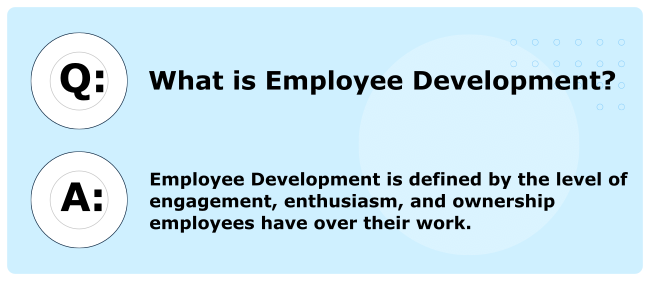Employee Development
Employee Development is defined by the level of engagement, enthusiasm, and ownership employees have over their work. Employers know that a more engaged workforce is more productive and has less turnover. An employee engagement strategy is all about answering the question – how can I improve my employee engagement? And ultimately, how do I attract, retain, and engage the most talented employees in my industry.
Read more about Employee Development below.

We are the trusted HR and Accounting partner for businesses of all sizes and specialties
Our HR Services
Monthly HR Support
Our team of dedicated HR professionals handle the day-to-day administrative complexities of HR, so you can focus on running your business. Learn more about Monthly HR Support
Strategic HR Initiatives
Whether you need support to push a specific initiative across the finish line, or a complete overhaul of a functional area, we can help. Learn more about Strategic HR Initiatives
Payroll Services
When it comes to payroll processing, there is no margin for error. Our payroll experts will use the right tools and design the right process to ensure success. Learn more about Payroll Services
Employee Engagement
Employee engagement is crucial for the success and productivity of your organization. We help you discover what is truly important to your team, and provide data-inspired solutions that make a real impact and increase employee engagement.
Accelerating Outcomes with Best in Class Technology
Get Started!
Transform your HR into a competitive advantage.
Employee Development

A healthy relationship between employer and employee is reciprocal: the success and welfare of the organization depends on the success of its people and their continued development. Professional development of employees has a long-term impact on the business. The investment of time and training promotes a sustained learning culture, and that’s attractive to current and potential talent.
In the current job market, businesses have to offer more than financial compensation to retain employees. Employees want to see added value in career development, their skills and training upgraded, exposure to new technology, and a vested role and inclusion in the business. They recognize an employee development process has a valuable aspect of a new job. By providing these benefits, an organization becomes more competitive, increases its retention, and creates a more dynamic, diverse workforce.
On paper, most businesses would opt for this kind of workplace culture. And many claim it already exists within their organization today.
But the reality is most businesses struggle to create a culture of employee development. How do businesses prioritize the development needs of an employee alongside quarterly production numbers?
It’s tough for businesses to build a culture of employee development. Here we’ll discuss types of employee development, clear objectives for businesses to reach, and what could be required from the business to create professional development opportunities within the organization.
What are Examples of Professional Development?
Real employee development strategies in the workplace go beyond toolbox talks, quarterly reviews, and training on software updates—though these examples can play a role in your employee development plan. Employee development strategies must benefit both the business and the employee and should have a long-term, holistic purpose. So what are examples of professional development? Look to employee benefits first, which can create momentum:
- Situational leadership opportunities
- Opportunities for upward mobility
- Increased skill sets and experience
- Measurable improvement of knowledge
- Improved morale, proactive employee engagement
These are milestones that represent development—they are indicators that your strategy is working. So how do you achieve those?
What are Development Activities in the Workplace?
We’ll look at five approaches to employee development, though there are many more strategies and activities you can introduce into the workplace. Companies often include outsourced HR consultants to help businesses develop additional activities in the workplace to engage employees. But the following are possible with your current team, at any stage.
Coaching/Mentoring
These strategies match experienced employees and company leaders with less-experienced employees to develop skill sets, improve performance, and to cross-train at the leadership level. This can also including hiring outside business coaches that focus on qualitative skills or emotional intelligence critical for leading teams. Job shadowing is one way to begin the coaching/mentorship process, but it can also be done through cross-training efforts.
Workshops
Workshops allow employees a third space away from their desk to get he creative juices flowing. Workshops can be geared towards operational improvement projects or innovative product conversations.
Cross-training
The more employees know how the business functions as a whole, the better they understand how their own role plays a part. It creates value for their role when they experience its counterpart. Job rotation is an effective tool to invite cross-training. Expose employees to environments beyond their day-to-day.
Stretch Assignments
Stretch assignments put employees in situations that go beyond their typical workday, encouraging their development and exposing them to situations they might engage in more regularly in the future. Presentations to leadership, mentorship programs, and cross-training/job rotations are all great stretch assignments.
Employee Development Plans
Do employees know you value their development? Employee development plans help communicate your intent, show that you value their growth, and provide the opportunity to have conversations between employees and leadership. These plans help better define what improvement looks like and how you might set and reach goals.
What is an Employee Development Example?
A learning and development needs example might include a particular department whose metrics don’t reflect an engaged or motivated team: turnover is high, few employees are promoted, the average tenure falls below the company average, and while the department functions, it does so without standout qualities that demonstrate an active, developmental culture. This is the difference between poor employee performance versus a lack of employee development and training.
So instead of focusing on improving the department’s performance, first look to employee development in the short-term, mid-term, and long-term. What can be done to try to demonstrate a positive, recursive growth model? And what types of training and development would be beneficial?
- Create opportunities for cross-training, exposing those employees to different departmental cultures.
- Use a coaching/mentor model to increase upward mobility and improve practices.
- Begin actively introducing stretch assignments that put those employees in new, engaging situations.
- Monitor metrics defined in employee development plans to see, over time, evidence of improvement.
How Does Training and Development Improve Employee Performance?
In theory, the more employees engage in their own development and training, the more the business grows as a whole. But what does this look like at ground level? What are the details that actually show a benefit when you invest in training and development?
Here are 10 benefits of training your employees and providing development opportunities:
- Promotes a company culture of positive improvement and growth.
- Turns static positions into dynamic roles.
- Reduced turnover and increased tenure.
- Improved employee morale and engagement.
- Increased upward mobility of employees.
- Improved teamwork and employee interaction.
- Adaptability to industry, market, and technology changes.
- Increased productivity without pressure, which improves retention.
- Company reputation (internal and external) improves, attracts talent.
- Exposure to networking, cross-training, new concepts.
How To Develop Employees
You can’t really force employee development, nor can you micromanage efforts. It’s up to the individual to make choices at their current position to take on new responsibilities and invest in their own development. But you can create a culture that promotes employee development and provides avenues for the process that are easily available and accessible.
- Identify and communicate business goals – Identify what success looks like for the business as a whole, setting metrics and milestones, and communicate those across your teams.
- Encourage a culture of employee development – Make it known that the business values employee development and that it’s willing to devote time and energy towards individuals’ personal growth.
- Create employee development plans – Employee development plans make your intentions official and help create unique pathways for employees, including training, goal-setting, and evaluation.
- Reward and incentivize development – Invest in employee development by rewarding and incentivizing any programs or strategies voluntary to your employees. They should know the organization considers their personal development an investment opportunity.
- Set clear onboarding expectations – We’ve been talking a lot about employee development for current employees, but new hires can be just as effective in creating a culture of employee development. Ensure your onboarding process focuses on creating pathways and expectations for employees to continue to grow at their hired-on positions.
These steps reflect the organization’s intent: to grow and improve through its employees. When you put action behind intent, more employees will take advantage of the momentum.
How Do You Write an Employee Development Plan?
Employee development plans help individuals systematically take control of their professional development. Clear training goals and objectives help employees perform better in their current role and acquire knowledge and encouragement to consider new responsibilities, roles, and even leadership positions within the company.
Creating an effective employee development plan comes down to the individual and creating a guidebook that helps identify personalized steps to take. Below we’ve outlined a few critical steps in creating an employee development plan.
- Define the big picture – All individual employee development plans should be in line with the business’ goals. All paths should support the business and act as the “why” behind the plan.
- Set individual expectations – The motivation for change has to come from the employee, so focus on the individual expectations they have for themselves in the short-term, mid-term, and long-term. What are goals you can set for each?
- Identify necessary skills and training – Create tangible steps to take to achieve the employee’s goals. What training, certifications, programs, or mentorships could help develop necessary skills?
- Create recursive momentum – Create a calendar to review progress, identify corrections, and set new goals.
- Foster continuous growth – Whenever a short-term, mid-term, or long-term expectation is fulfilled, set new ones. The pathway to employee development is never over—its objectives just morph.
While creating a plan like this for each one of your employees might feel overwhelming, the effort helps create an overall mentality of self-motivation and personal responsibility. Still, many companies require the help of outsourced HR consultants to put these strategies into place more effectively.
Employee Development Through HR Outsourcing
HR outsourcing involves an independent partner with established processes and strategies to jump-start a culture of employee development. But businesses also need a partner who understands the importance of investing in the company’s future and taking the time to identify needs versus simply respond to crises. In fact, 44% of businesses say their biggest challenge working with outsourced HR is that vendors take a reactive versus proactive approach to issues.
Employee development is a proactive approach to HR. It puts your people and your business first simultaneously, by creating a culture that supports those wanting to further their careers, their departments, and the business as a whole. At Milestone, we understand how to begin this process from the ground level up.
There are many models of working with an HR outsourcing provider. Milestone has flexible offerings that meet your business’ needs, whether that means working with your current internal human resources professional for additional support, or if you want us to manage all strategic human resource objectives. At Milestone, we provide our clients unique HR outsourcing packages that don’t require a long-term contract and outline exactly what to expect.
Want to learn more? Contact us today and start a conversation that could lead to impactful change in your business.


